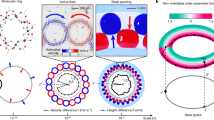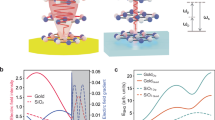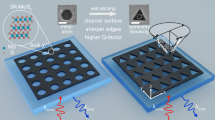Abstract
Atomic and molecular structure inversion symmetry breaking in naturally occurring crystals dictate their physical properties including nonlinear optical (NLO) effects, piezo- or ferroelectricity, and non-reciprocal charge transport behaviour. With metamaterials composed of nanoscale building blocks (that is, meta-atoms), the spatial inversion symmetry violation on planar surfaces leads to spin-controlled photonics as well as NLO metasurfaces. Synthetically, low-symmetry 3D metacrystals can be synthesized, but NLO behaviour has not been identified so far (for example, harmonic generations). Herein we show how DNA-mediated assembly of octahedron-shaped plasmonic gold nanocrystals can be used to design and deliberately synthesize non-centrosymmetric and centrosymmetric colloidal crystals. Importantly, while the centrosymmetric structures do not exhibit substantial second-harmonic generation, the non-centrosymmetric crystals do—a consequence of the asymmetric distribution of localized electric fields in plasmonic hotspots. Moreover, this non-centrosymmetric NLO metacrystal represents a 3D NLO metamaterial being developed via a bottom-up approach, exhibiting a maximum second-harmonic generation conversion efficiency of 10−9 to surpass the efficiencies observed in the majority of plasmonic 2D metasurfaces. Finally, the DNA-loading density on the particle building blocks can be used to toggle between the centrosymmetric and non-centrosymmetric phases.
This is a preview of subscription content, access via your institution
Access options
Access Nature and 54 other Nature Portfolio journals
Get Nature+, our best-value online-access subscription
$32.99 / 30 days
cancel any time
Subscribe to this journal
Receive 12 print issues and online access
$259.00 per year
only $21.58 per issue
Buy this article
- Purchase on SpringerLink
- Instant access to full article PDF
Prices may be subject to local taxes which are calculated during checkout





Similar content being viewed by others
Data availability
All the data supporting the findings of this study are available within this Article and its Supplementary Information. Any additional information can be obtained from the corresponding authors on reasonable request. Source Data are provided with this paper.
References
Prelog, V. Chirality in chemistry. Science 193, 17–24 (1976).
Tang, Y. & Cohen, A. E. Optical chirality and its interaction with matter. Phys. Rev. Lett. 104, 163901 (2010).
Ma, W. et al. Chiral inorganic nanostructures. Chem. Rev. 117, 8041–8093 (2017).
Verbiest, T. et al. Strong enhancement of nonlinear optical properties through supramolecular chirality. Science 282, 913–915 (1998).
Kenzelmann, M. et al. Magnetic inversion symmetry breaking and ferroelectricity in TbMnO3. Phys. Rev. Lett. 95, 87206 (2005).
Yao, W., Xiao, D. & Niu, Q. Valley-dependent optoelectronics from inversion symmetry breaking. Phys. Rev. B 77, 235406 (2008).
Boyd, R. W. Nonlinear Optics 3rd edn (Academic, 2008).
Wang, J.-Q. et al. Synthetic five-wave mixing in an integrated microcavity for visible-telecom entanglement generation. Nat. Commun. 13, 6223 (2022).
Berger, V. Nonlinear photonic crystals. Phys. Rev. Lett. 81, 4136–4139 (1998).
Lu, X., Moille, G., Rao, A., Westly, D. A. & Srinivasan, K. Efficient photoinduced second-harmonic generation in silicon nitride photonics. Nat. Photon. 15, 131–136 (2021).
Corn, R. M. & Higgins, D. A. Optical second harmonic generation as a probe of surface chemistry. Chem. Rev. 94, 107–125 (1994).
Yamamoto, S. et al. Element selectivity in second-harmonic generation of GaFeO3 by a soft-X-ray free-electron laser. Phys. Rev. Lett. 120, 223902 (2018).
Campagnola, P. J. & Loew, L. M. Second-harmonic imaging microscopy for visualizing biomolecular arrays in cells, tissues and organisms. Nat. Biotechnol. 21, 1356–1360 (2003).
Chen, X., Nadiarynkh, O., Plotnikov, S. & Campagnola, P. J. Second harmonic generation microscopy for quantitative analysis of collagen fibrillar structure. Nat. Protoc. 7, 654–669 (2012).
Franken, P. A., Hill, A. E., Peters, C. W. & Weinreich, G. Generation of optical harmonics. Phys. Rev. Lett. 7, 118 (1961).
Zhang, Y., Grady, N. K., Ayala-Orozco, C. & Halas, N. J. Three-dimensional nanostructures as highly efficient generators of second harmonic light. Nano Lett. 11, 5519–5523 (2011).
Li, G., Zhang, S. & Zentgraf, T. Nonlinear photonic metasurfaces. Nat. Rev. Mater. 2, 17010 (2017).
Kauranen, M. & Zayats, A. V. Nonlinear plasmonics. Nat. Photon. 6, 737–748 (2012).
Canfield, B. K. et al. Local field asymmetry drives second-harmonic generation in noncentrosymmetric nanodimers. Nano Lett. 7, 1251–1255 (2007).
Suchowski, H. et al. Phase mismatch–free nonlinear propagation in optical zero-index materials. Science. 342, 1223–1226 (2013).
Laramy, C. R., O’Brien, M. N. & Mirkin, C. A. Crystal engineering with DNA. Nat. Rev. Mater. 4, 201–224 (2019).
Wang, S. et al. The emergence of valency in colloidal crystals through electron equivalents. Nat. Mater. 21, 580–587 (2022).
Macfarlane, R. J., O’Brien, M. N., Petrosko, S. H. & Mirkin, C. A. Nucleic acid-modified nanostructures as programmable atom equivalents: forging a new “table of elements”. Angew. Chem. Int. Ed. 52, 5688–5698 (2013).
Macfarlane, R. J. et al. Nanoparticle superlattice engineering with DNA. Science 334, 204–208 (2011).
Macfarlane, R. J. et al. Importance of the DNA “bond” in programmable nanoparticle crystallization. Proc. Natl Acad. Sci. USA 111, 14995–15000 (2014).
Mirkin, C. A., Letsinger, R. L., Mucic, R. C. & Storhoff, J. J. A DNA-based method for rationally assembling nanoparticles into macroscopic materials. Nature 382, 607–609 (1996).
Samanta, D., Zhou, W., Ebrahimi, S. B., Petrosko, S. H. & Mirkin, C. A. Programmable matter: the nanoparticle atom and DNA bond. Adv. Mater. 34, 2107875 (2022).
Thaner, R. V. et al. The significance of multivalent bonding motifs and “bond order” in DNA-directed nanoparticle crystallization. J. Am. Chem. Soc. 138, 6119–6122 (2016).
Zhou, W. et al. Space-tiled colloidal crystals from DNA-forced shape-complementary polyhedra pairing. Science 383, 312–319 (2024).
Li, Y. et al. Open-channel metal particle superlattices. Nature 611, 695–701 (2022).
Kim, S. et al. Mie-resonant three-dimensional metacrystals. Nano Lett. 20, 8096–8101 (2020).
Zhou, W. et al. Device-quality, reconfigurable metamaterials from shape-directed nanocrystal assembly. Proc. Natl Acad. Sci. USA 117, 21052–21057 (2020).
Li, Y. et al. Monolayer plasmonic nanoframes as large-area, broadband metasurface absorbers. Small 18, 2201171 (2022).
Lin, Q.-Y. et al. Strong coupling between plasmonic gap modes and photonic lattice modes in DNA-assembled gold nanocube arrays. Nano Lett. 15, 4699–4703 (2015).
Park, D. J. et al. Plasmonic photonic crystals realized through DNA-programmable assembly. Proc. Natl Acad. Sci. USA 112, 977–981 (2015).
Auyeung, E., Macfarlane, R. J., Choi, C. H. J., Cutler, J. I. & Mirkin, C. A. Transitioning DNA-engineered nanoparticle superlattices from solution to the solid state. Adv. Mater. 24, 5181–5186 (2012).
Henzie, J., Grünwald, M., Widmer-Cooper, A., Geissler, P. L. & Yang, P. Self-assembly of uniform polyhedral silver nanocrystals into densest packings and exotic superlattices. Nat. Mater. 11, 131–137 (2012).
Bozhevolnyi, S. I., Beermann, J. & Coello, V. Direct observation of localized second-harmonic enhancement in random metal nanostructures. Phys. Rev. Lett. 90, 197403 (2003).
Celebrano, M. et al. Mode matching in multiresonant plasmonic nanoantennas for enhanced second harmonic generation. Nat. Nanotechnol. 10, 412–417 (2015).
Zhang, S. et al. Pronounced Fano resonance in single gold split nanodisks with 15 nm split gaps for intensive second harmonic generation. ACS Nano 10, 11105–11114 (2016).
Klein, M. W., Wegener, M., Feth, N. & Linden, S. Experiments on second- and third-harmonic generation from magnetic metamaterials: erratum. Opt. Express 16, 8055 (2008).
Feth, N. et al. Second-harmonic generation from complementary split-ring resonators. Opt. Lett. 33, 1975–1977 (2008).
O’Brien, M. N., Jones, M. R., Brown, K. A. & Mirkin, C. A. Universal noble metal nanoparticle seeds realized through iterative reductive growth and oxidative dissolution reactions. J. Am. Chem. Soc. 136, 7603–7606 (2014).
Rasband, W. S. ImageJ (US National Institutes of Health, 1997–2018); https://imagej.net/ij/
Schneider, C. A., Rasband, W. S. & Eliceiri, K. W. NIH Image to ImageJ: 25 years of image analysis. Nat. Methods 9, 671–675 (2012).
Kim, Y. & Vogel, S. S. Measuring two-photon microscopy ultrafast laser pulse duration at the sample plane using time-correlated single-photon counting. J. Biomed. Opt. 25, 14516 (2020).
Sullivan, D. M. Electromagnetic Simulation Using the FDTD Method (John Wiley & Sons, 2013).
Johnson, P. B. & Christy, R. W. Optical constants of the noble metals. Phys. Rev. B 6, 4370–4379 (1972).
Palik, E. D. Handbook of Optical Constants of Solids Vol. 3 (Academic, 1998).
Acknowledgements
We thank J. Orbeck for providing editorial input, and R. Chan, K. Landy, Z. Li and K. Gibson for technical help and fruitful discussions. We also thank M. Hersam for supporting the access to the laser equipment. This material is based on work supported by the Air Force Office of Scientific Research award FA9550-22-1-0300 (nanocrystal synthesis and assembly, optical simulation); the Center for Bio-Inspired Energy Science, an Energy Frontier Research Center funded by the US Department of Energy, Office of Science, Basic Energy Sciences award DE-SC0000989 (DNA functionalization); an Army Research Office grant W911NF-23-1-0141 (SEM characterizations); and the Sherman Fairchild Foundation (SHG measurements). This work made use of the EPIC facility (NUANCE Center-Northwestern University), which has received support from the Soft and Hybrid Nanotechnology Experimental (SHyNE) Resource (NSF ECCS-2025633); the MRSEC program (NSF DMR-1121262) at the Materials Research Center; the International Institute for Nanotechnology (IIN); and the State of Illinois, through the IIN.
Author information
Authors and Affiliations
Contributions
Y.Z. and C.A.M. conceived the idea. Y.Z. performed the synthesis and characterization of colloidal crystals with the help from W.Z. and Y.L. D.D.X. and Y.Z. designed and performed the SHG experiments. I.T. performed the optical simulation. R.L.A. conducted pulse width measurement experiments. C.A.M. and K.A. supervised the project. Y.Z. analysed the data and wrote the initial draft. All authors contributed to interpreting the data and writing or commenting on the manuscript.
Corresponding authors
Ethics declarations
Competing interests
The authors declare no competing interests.
Peer review
Peer review information
Nature Photonics thanks Huigao Duan, Hui Zhao and the other, anonymous, reviewer(s) for their contribution to the peer review of this work.
Additional information
Publisher’s note Springer Nature remains neutral with regard to jurisdictional claims in published maps and institutional affiliations.
Supplementary information
Supplementary information
Supplementary Sections 1–4, Tables 1–10 and Figs. 1–26.
Rights and permissions
Springer Nature or its licensor (e.g. a society or other partner) holds exclusive rights to this article under a publishing agreement with the author(s) or other rightsholder(s); author self-archiving of the accepted manuscript version of this article is solely governed by the terms of such publishing agreement and applicable law.
About this article
Cite this article
Zhang, Y., Xu, D.D., Tanriover, I. et al. Nonlinear optical colloidal metacrystals. Nat. Photon. 19, 20–27 (2025). https://doi.org/10.1038/s41566-024-01558-0
Received:
Accepted:
Published:
Issue date:
DOI: https://doi.org/10.1038/s41566-024-01558-0
This article is cited by
-
The nucleic acid reactions on the nanomaterials surface for biomedicine
Journal of Nanobiotechnology (2025)
-
Efficient second-harmonic generation in 3D colloidal crystals
Nature Photonics (2025)



